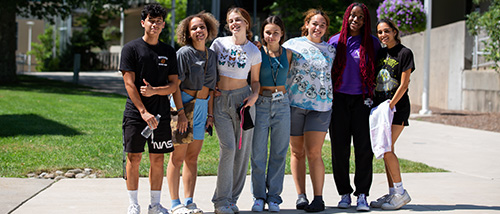Getting Involved in Diversity & Inclusion Work
By Valerie Hayes
Chief Officer for Diversity and Inclusion
Diversity is more than the characteristics of race, ethnicity and sex/gender, which
cut across all groups of individuals. Inclusion is more than individuals coming together
in one large place. At Stockton, diversity includes the categories of disability,
national origin, age, religion, veteran status and much more. Diversity encompasses
our multi-faceted identities because, as individuals, we do not have just one identity.
 We spend much our lives working. In higher education, where we work is one of the
places we share a sense of belonging with employees and students who hail from different
backgrounds and experiences than our own. We learn about and from each other. We also
learn that our individual ideas and contributions matter. More importantly, our ideas
and contributions can impact and lend support to the University’s commitment to diversity
and inclusion.
We spend much our lives working. In higher education, where we work is one of the
places we share a sense of belonging with employees and students who hail from different
backgrounds and experiences than our own. We learn about and from each other. We also
learn that our individual ideas and contributions matter. More importantly, our ideas
and contributions can impact and lend support to the University’s commitment to diversity
and inclusion.
Stockton expresses its commitment to diversity and inclusion in several ways—through its Statement on Diversity, Equity and Inclusion, its Mission, Vision and Values Statements, and its Commitment to Diversity. Several diversity and inclusion efforts also are noted in the University’s Response to Social Justice Concerns. Diversity committees help an institution enact its commitment to diversity and inclusion, bringing life to the words on a webpage.
There is little research available on diversity committees; however, the research that does exist is instructive. There are two types of diversity committees, one focused on implementation, and the other focused on strategy. Both types of diversity committees engage in strategic thinking to advance an institution’s espoused commitment to diversity and inclusion (Leon & Williams, 2016; Williams, 2013).
For diversity committees to effectively do their work, there needs to be harmony between an institution’s espoused or expressed commitment to diversity and inclusion and the realities that support or hinder diversity committees from doing diversity work (Anderson, 2019).
The Diversity Committee is the longest standing University committee, established by policy in 1981. Their collaborative work is implementation-focused, accomplished through several working subcommittees. For example, the Campus Climate subcommittee designed, distributed, evaluated results and made recommendations based on the data collected in the 2016 employee campus climate survey. Highlights from a document prepared by Zornitsa Kalibatseva (Psychology) reveal that the survey questions focused on the perception of overall campus climate, personal campus experiences and perceptions of Stockton’s institutional actions.
Several recommendations emerged from the employee campus climate survey. Actions taken in response to the recommendations are summarized below.
- There were three facilitated discussions with faculty and staff led by two faculty members in Fall 2017.
- A faculty member and the Training and Organizational Development professional in the Office of Human Resources developed and conducted multiple trainings with faculty and staff on implicit bias, microaggressions, inclusion, and anti-bullying between Spring 2018 and Fall 2019.
- An Ombudsperson was hired to serve as an intermediary between those who experienced exclusionary behavior and those who perpetuate those behaviors.
- On July 2, 2020, President Kesselman shared information [with the campus community] about the investigation process and summary EEO claim statistics between 2015 and 2020. The investigation process underwent an audit and changes were made accordingly.
- The Office of Diversity and Inclusion was created in August 2020, with the Chief Officer of the former Office of Institutional Diversity and Inclusion as the Chief Officer for Diversity and Inclusion.
- The renamed Bias Prevention Education and Review Team (formerly called Bias Response Team) was restructured to better emphasize its education role.
- Senior leadership engaged in conversations on race, starting in July 2020 to ensure they understand and address issues pertaining to race/ethnicity on campus.
During the strategic planning process, a second diversity committee emerged arising from one of the six key areas, the Strategic Planning Diversity and Inclusion Team. Although the team accomplished its task of developing three Diversity and Inclusion (D&I) implementation goals for inclusion in the 2025 Strategic Plan, the team continued to meet to discuss ways they could strategically assist the campus community in contributing to one or more of the three implementation goals.
In Spring 2021, the team pivoted from implementation-focused to strategy-focused by discussing ways in which they could bolster campus community involvement with the three broad D&I implementation goals. The team is in the process of generating ideas and best practices to assist the campus community as they prepare proposals to the Compass Fund, an internal Strategic Plan funding mechanism. As Leon and Williams (2016) assert in their research, pivoting in this direction allows a “strategy focused” team the ability to align ideas and best practices with each D&I implementation goal, “provide campus voice for diversity issues,” and “communicate with campus constituents” (p. 401), along with providing guidance on D&I planning and assessment.
We welcome participation from the campus community on the diversity committees. If you are interested in actively participating on one or both diversity committees, please contact Valerie Hayes at Valerie.Hayes@stockton.edu.
References
Anderson, R. K. (2019). Preaching to the choir: University diversity committees as affective communities. Anthropology & Education Quarterly, 51(1), 47-65.
Kalibatseva, Z. (2021). Summary of the 2016 Employee Campus Climate Survey Report and Actions Related to the Report Recommendations.
Leon, R. A. & Williams, D. A. (2016). Contingencies for success: Examining diversity committees in higher education. Innovative Higher Education, 41(5), 395-410.
Williams, D. A. (2013). Strategic diversity leadership: Activating change and transformation in higher education. Sterling VA: Stylus Publishing.


